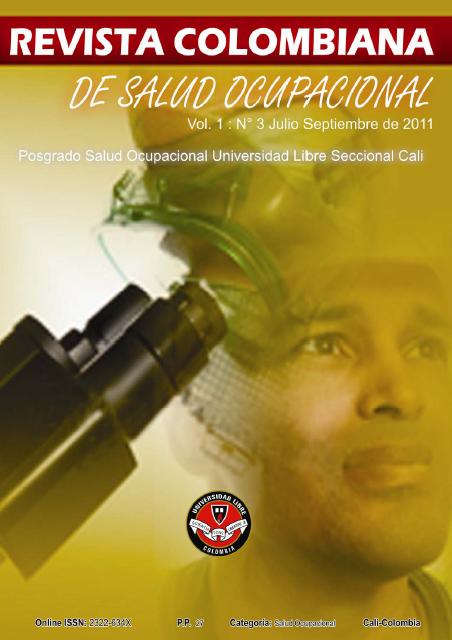Psychosocial risk factors, Burnout and work engagement in workers of small shops in commercial squares of Guadalajara.
Keywords:
Burnout, Work Engagement, psychosocial riskAbstract
The psychosocial “risk factors" understood as the interactions that are produced because of the work can exert both a harmful influence and positive to the health. Between the harmful results highlights the Burnout considered like the final state of a progression of failure attempts to handle the occupational stress, whereas between the positive situations we will signal the Work Engagement as a motivational concept beneficial to the health related to the work and the life.
Methodology: The research is a type of study transversal, observational and descriptive. The population is constituted by workers of small shops in commercial squares of Guadalajara (Mexico), taking in to account 112 individuals.
Results: 92% were women and 8% men. The ages ranged between 15 and 52 years but 89.3% were minor of 30 years; 73.2% single; people with negative psychosocial factors (78.6%) perceive an excessive “Work Load”; 65 (58%) "Content and Characteristic of the Task”; 78 (69.7%) “Work Requirements” and 56 (50%) was affected in the “Job Role and Career Development”. The socio-demographic variables do not have any influence in: the exposure to Psychosocial Factors of Work Risk, the presence of Burnout and the level of Work Engagement. Regarding the Burnout, the “Depersonalization” showed 59.9% “burned”, and 30.4% presented at least 2 burned dimensions. From the Engagement 55.3% have a high qualification in “wellbeing”; 63.4% in “Dedication”; and 60.7% in "Absorption”. There was found a significant association of some forms of Psychosocial Work Factors in both the Burnout, and the Work Engagement.
Conclusions: the quality of the Psychosocial Factors affects the presence of Burnout and / or Work engagement.
Downloads
References
Villalobos G. (1999). Identificación y evaluación de factores de riesgo psicosocial. Bogotá: Congreso del Consejo Colombiano de Seguridad.
Organización Internacional del Trabajo, 1986. Prevención de accidentes. México: OIT.
Velásquez, M. Los riesgos psico-sociales en el trabajo, 2003. Consultado en: http://www.arearh.com/salud%20laboral/psicosociales2.htm
Moncada, S.; Artazcoz, L. Factores psicosociales. En: Benavides, F.G.; Ruiz-Frutos, C.; García, A.M. eds. salud laboral.Conceptos y técnicas para la prevención de riesgos laborales. Barcelona; Masson, S.A., 2000. 389–399.
Gil-Monte, P., Peiró Silla, J.M. (1997). Desgaste psíquico en el trabajo: el síndrome de quemarse. España; Editorial Síntesis Psicología.
Gil-Monte P.R. (2000). Aproximaciones psicosociales y estudios diagnósticos sobre el Síndrome de Quemarse por el trabajo (Burnout). Monográfico, Revista de Psicología del Trabajo y de las Organizaciones 101-102.
Freudenberger HJ. (1974). Burn-out. J Social Issues.; 30:159-65.
Maslach , C.. and Jackson, S. E. (1979). 'Burned-out cops and their families'. Psychology Today. 1202). 59-62.
Seligman, M.E.P. & Csikszentmihalyi M., (2000). Positive psychology: An introduction. American Psychologist, 55, 5-14.
Salanova, M., & Schaufeli,W. B. (2000). Exposure to information technologies and its relation to Burnout. Behaviour & Information Technology, 19, 385-392.
Schaufeli, W.B., Salanova, M., Gonzalez-Roma. V. & Bakker, A.B. (2002). The measurement of engagement and Burnout and: A confirmative analytic approach. Journal of Happiness Studies, 3, 71.
Martínez, I., Marqués, A., Salanova, M. y López da Silva, A. (2002). Burnout en estudiantes universitarios de Espafia y Portugal. Ansiedad y Estrés, 8, 13-23.
Silva B., (2006). Factores psicosociales y desgaste profesional en académicos. Tesis de grado Doctorado en Ciencias de la Salud en el Trabajo, Universidad de Guadalajara, México.
Maslach C, Jackson SE. Maslach Burnout Inventory. Palo Alto California: Consulting Psychologists Press, 1981.
Maslach C, Jackson SE. Maslach Burnout Inventory. 2da. Edición. Palo Alto California: Consulting Psychologists Press, 1986.
Schaufeli Wilmar & Bakker Arnold. UWES Utrecht Work Engagement Scale Preliminary Manual [Version 1, November] Occupational Health Psychology Unit, Utrecht University, 2003
Ferrando, J. y Pérez, J. (1996). Un instrumento para medir quemazón profesional en los docentes: adaptación catalana del Maslach Burnout Inventory (MBI). Rev. Psiquiatría Fac. Med. Barna, 23,1, 11.
World Medical Association Declaration Of Helsinki. Ethical Principles for Medical Research Involving Human Subjects. 59th WMA General Assembly, Seoul, October 2008.
Pando M., Carrion M., Arellano G., (2006). Factores Psicosociales y salud mental en el trabajo. Cap III. Los factores psicosociales en el trabajo pp. 68-86. Guadalajara, México.
Aranda C., Pando M., Salazar J. Torres T., Aldrete M & Pérez M. (2004a). Factores Psicosociales Laborales y Síndrome de Burnout en Médicos del primer nivel de atención. Investigación en salud/Vol. 6, numero 001. Universidad de Guadalajara, México.pp.28-34.
Mireles A, Pando M, Aranda C. (2002) Factores psicosociales y Síndrome de Burnout en una empresa de la rama textil en Guadalajara, México. Investigación en Salud; Vol. IV, No.2, México, pp 104-110.
Sol M., Alvarado R. (2008). Factores psicosociales del trabajo y síndrome de Burnout en trabajadores de la salud. Revista de Salud Pública, (XII) 2: 6-13. Consultado el 27-08-09 obtenida de http://www.saludpublica.fcm.unc.edu.ar/docs/revista/2008/08_nu m2_vol12/art1_pastorino.pdf.
Aranda C., Pando M., Aldrete Mª., Salazar J., Torres T., (2004b). Síndrome de Burnout y apoyo social en los médicos familiares de base del Instituto Mexicano del Seguro Social (IMSS). Guadalajara, México Rev. Psiquiatría Fac. Med. Barna; Pp: 142-150.
Yperen, N.W., Buunk B.P y Schaunfeli W.B. Communal orientation and the Burnout syndrome among nurse, Journal of Applied Social Psychology, 1992, 22: 173-189.


